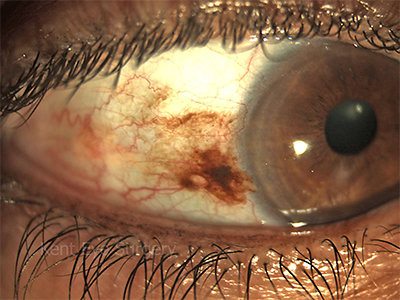Pigmentation of the conjunctiva is not uncommon, occuring in as many as 36% of adult Caucasians (Gloor et a. IOVS 1995). Most patients never come to clinical attention, but very occasionally, this pigmentation may presage the development of conjunctival melanoma. It needs to be distinguished from racial melanocystois, which is usually bilateral and symmetrical. On the other hand, primary aquired melanosis of the conjunctiva (PAM) is usually unilateral (90% of cases) and is commonly, but not exclusively, observed in Caucasians. This is an example of PAM affecting a patient of African extraction and involves just over 1 clock hour of bulbar conjunctiva:-
The risk of melanoma is determined i) by the number of clock hours of bulbar conjunctiva affected and ii) by the histological characteristics of the pigmentation. Involvement of the caruncle or cornea does not increase the risk of melanoma. In Sheilds study (Ophthalmology 2008) the risk of melanoma development in patients with 4 clock hours involvment was 6.8 times that of patients with only 1 clock hour involved. In PAM without atypia or with mild atypia, the risk of melanoma was 0%, compared to 13% in patients with severe atypia. None of 9% patients with conjunctival melanoma diagnosed during this study had developed systemic metastases.
Most patients with PAM can be managed by observation. For patients with more than 2 clock hours involvement, the lesion should be biopsied and cryotherapy or mitomycin C considered. Where conjunctival closure is likely to be problematic, amniotic membrane should be ordered in advance.


